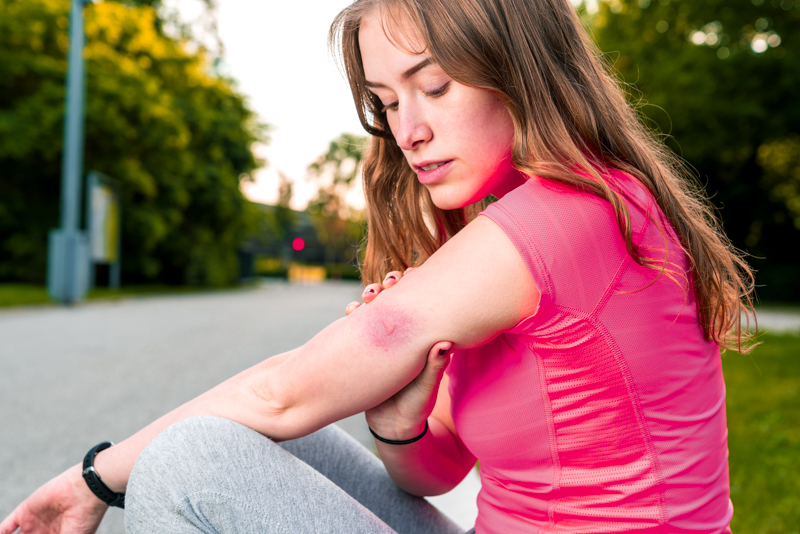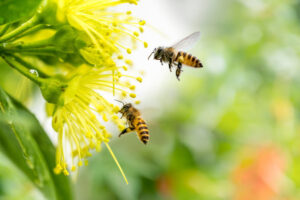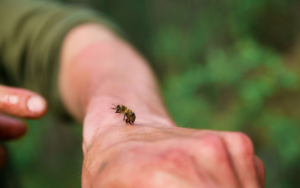Did you know that roughly 7% of the population is allergic bees and wasps?4 You or a loved one may be allergic and not know until you’re stung. That’s why it’s important to know what symptoms to expect, how to respond, and a relative bee sting allergic reaction time frame.
You've been stung. Now what?
The first few seconds after a sting are the most important. However, they can also be the most distressing. Most likely, you weren’t expecting to be stung by a bee or wasp. It is important to remain calm and remember these three steps.
#1 Act Calm
We’ve already stated the importance of remaining calm, but it’s worth repeating. Many people feel an urge to swat at insects, run, and express frustration. All of these responses could make matters worse. When possible, remain composed.
#2 Be Aware of Your Surroundings
Next, notice what is around you. Is there more than one bee or wasp? Make sure to head away from their nest and not toward it. Also, some nests may be underground in a hole. Watch your step as you leave the area.
#3 Consider Your Symptoms
Last, notice your symptoms. At its worst, a severe allergic reaction can happen within minutes. If you’re finding it difficult to breathe or continue standing, don’t take a risk. Call 911 or ask someone to call on your behalf.
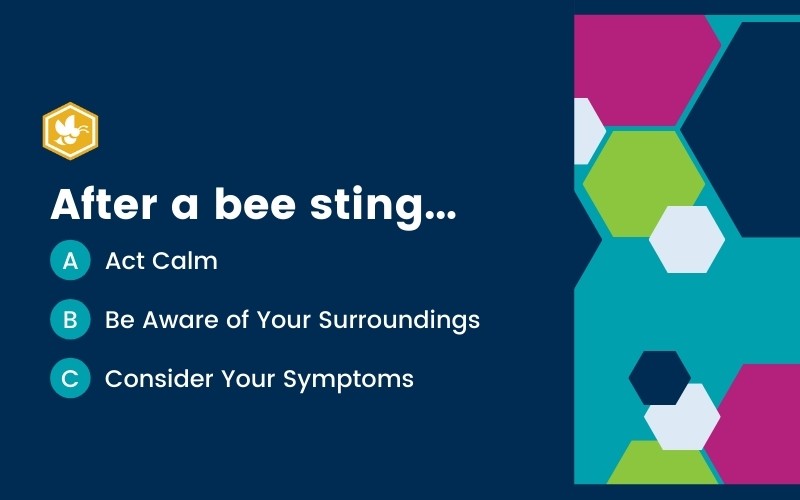
BEE STING ALLERGIC REACTION TIME FRAME
Right Away
Move to Safety
Limit your contact with venom. Quickly leave the area without disturbing more insects. Then, scrape out any remaining stingers.
5 Minutes After
Take Notice
A deadly allergic reaction can occur within minutes. If you notice any difficulty breathing or other serious symptoms, call 911.
30 Minutes After
Reduce Symptoms
Antihistamines, anti-itch cream, and ice can help with swelling and discomfort. Continue watching for severe symptoms.
2 - 12 Hours After
Stay Vigilant
Sometimes, severe allergic reactions occur up to 12 hours after an interaction. If your symptoms increase rapidly, don’t wait. Call 911.
24 Hours After
Take Action
If you experienced hives, intense swelling, or other concerning symptoms, talk to an allergist. Your risk for another severe reaction may have increased!
Discover Venom immunotherapy

IN-DEPTH TIME FRAME: AFTER A BEE STING
Looking for more information? Keep reading for a deeper dive into what to expect after a bee or wasp sting.
Right Away
When a bee or wasp stings, they inject toxic venom into their victim. The more venom you are exposed to, the worse your reaction may be.
Wasps are capable of stinging multiple times and are very aggressive. If you believe you have been stung by wasps, it is important to calmly leave the area. Swatting, stepping into a ground nest, or any further affront could lead to additional injuries.
Bees only attack once because their stinger becomes lodged in the skin. However, if the stinger is in contact with you there is a potential for the venom sac to excrete more toxins. First, move to a safe place. Then, use your fingernail or another tool to scrape the stinger out. Never squeeze the venom sac to remove it. Doing so releases toxins.
The First Few Minutes After
The time frame for an allergic reaction differs for everyone. It is important to know that anaphylaxis, a deadly type of reaction, can occur within minutes. So, if you sense impending doom, dizziness, nausea, or tightness of the throat, do not dismiss these symptoms. They may quickly lead to trouble breathing and even cardiac arrest. Call 911 if you suspect you are having a severe allergic reaction to a bee or wasp sting.
Even if you do not immediately become symptomatic, continue monitoring your body.
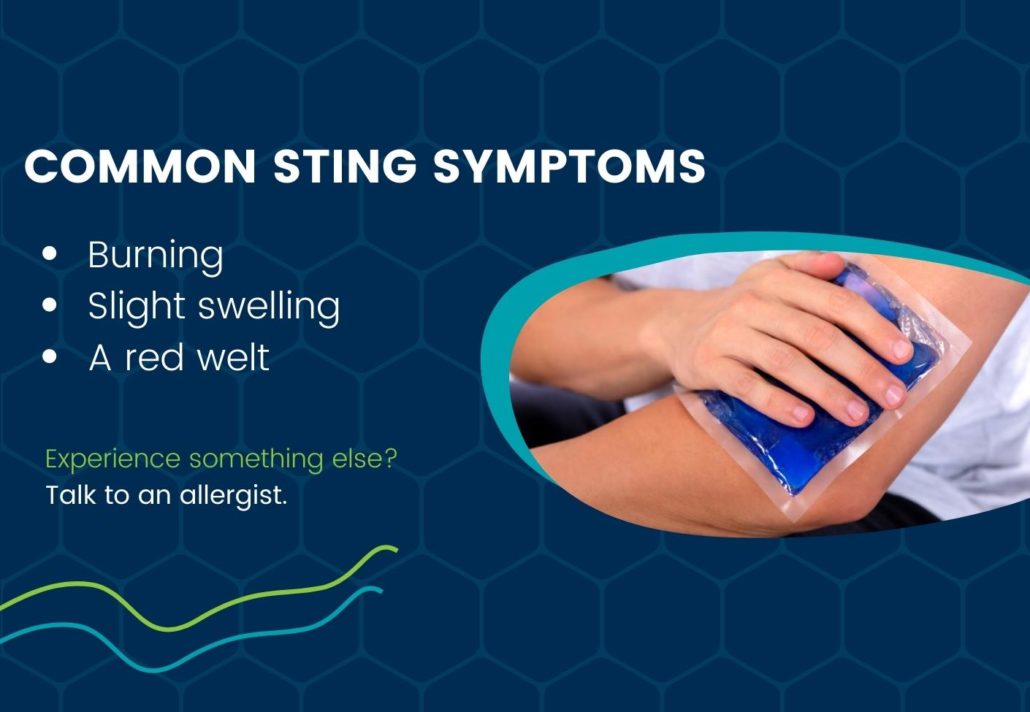
30 Minutes After
The first few minutes after a bee or wasp sting is all about safety. Once you are inside and calm, consider any first aid you may need. The most common symptoms are burning, slight swelling, and a red welt at the sting site. Antihistamines, anti-itch cream, and ice are great options for treating these inconveniences.
12 Hours After
Like we shared before, the time frame for bee sting allergic reactions is different for each person. Sometimes, anaphylaxis is delayed, occuring up to 12 hours after contact with an allergen. Stay aware of your symptoms and don’t dismiss any concerns.
Signs of an increasing reaction may include itchy or watery eyes, runny nose, a rash, and increased swelling at the site. Antihistamines can be helpful with these symptoms, but you should take note of them. They could be signs of a worsening condition.
24 Hours After
Now it’s time to reflect on your bee or wasp sting. Did you experience any moderate or severe symptoms? Stinging insect allergies can worsen over time. So, it is crucial to contact an allergist and discover your risk for anaphylaxis with your next sting. By taking action, you can prevent an emergency.
Also, consider how you were able to respond in the first few minutes after the incident. Did you remain calm, know where to go, and stay alert? Use this experience to respond better next time and learn how you would handle someone else being stung. Every second counts if there is a deadly allergic reaction.
Be prepared for bee & WASP stings
Now that you’ve learned about the time frame for bee sting allergic reactions, take action! You can create your own safety plan, continue learning about treatment, or contact an allergist. It’s always the right time to prevent an emergency.


Find a Local Allergist
If you think you have a bee sting allergy, don’t wait for an emergency. Instead, talk to an allergist about testing and venom immunotherapy.


